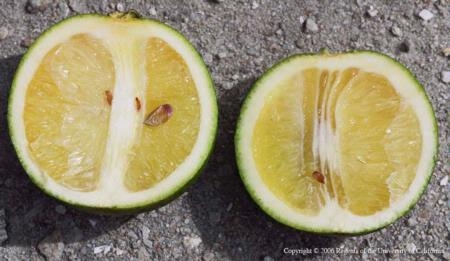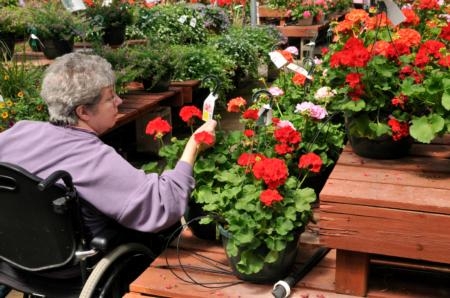- Author: Chris M. Webb
Asian citrus psyllid, has not recently received much attention in the news media. However the pest, and the deadly bacterial disease it can carry, are still of great concern.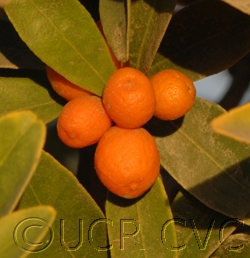
The Asian citrus psyllid (ACP) has now been found in eight California counties. Quarantines are in place. The psyllid by itself is not much of a problem; it is its ability to spread the fatal disease that has the potential to devastate both the California citrus industry and backyard citrus throughout the state.
Huanglongbing (HLB) is the name of the disease ACP can carry. Citrus and closely related plants are at risk. The disease is transmitted between plants by the psyllid. The psyllids transmit the disease to healthy plants and trees. After feeding on an infected plant, the ACP will transmit HLB to every other plant it feeds on.
While much outreach has focused on citrus trees, it is important to remember there are other plants that can host both ACP and HLB. This list from the University of Florida provides both the common and Latin plant name for many known hosts. Hosts include: curry leaf, ornamental orange-jasmine, and all the varieties of citrus, including kumquat, mandarin, grapefruit, orange and all of their hybrids.
Please remember to check your citrus and closely related plants regularly for signs of ACP or HLB. General information about this pest disease complex can be found on this section of the CDFA website. For local updates, the Ventura County ACP Task Force is a great source of information.
- Author: Chris M. Webb
Produced by UC’s Statewide IPM (Integrated Pest Management) Program, Retail Nursery and Garden Center IPM News is designed to educate retail center operators and their customers on how to solve pest problems while minimizing risks to people and the environment.
The current issue features:
- Managing powdery mildew on ornamentals
- Asian citrus psyllid update
- Mushrooms and other nuisance fungi in lawns
- Preliminary report on Iron HEDTA: A natural selective herbicide
- National Pesticide Information Center: A good source of pesticide information for your customers
You may subscribe to the newsletter, read back issues, or contact authors by visiting this page of UC IPM Online.
- Author: Chris M. Webb
After the recent HLB detection in Los Angeles County, many people have been contacting our office. We would like to take this opportunity to remind you about the Ventura County ACP-HLB Task Force.
The Task Force, founded January 2010, “is dedicated to the early detection and swift eradication of this invasive pest, and to preventing the disease it transmits from devastating Ventura County citrus.”
To allow for quick exchange of information and open communication, the Task Force is on Facebook. The information and resources available on their page are extensive.
Recently added resources include a free smart phone app from the USDA designed to help report suspected citrus diseases, including HLB.
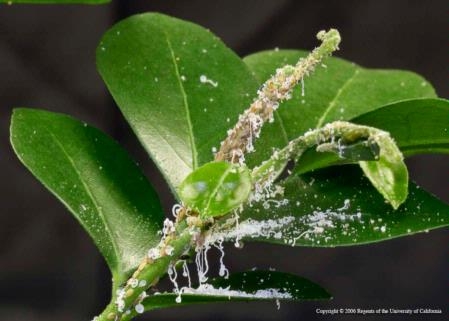
- Author: Chris M. Webb
Research to fight Huanglongbing (HLB), the deadly citrus disease carried by the Asian citrus psyllid, is taking place throughout our nation and the world. Industry-wide urgency is funding a variety of research in search of a solution.
In 2010 a National Academy of Sciences panel concluded that genetic engineering “holds the greatest hope”. A promising genetic engineering study, developed by a scientist at Texas A&M’s Texas AgriLife Research and Extension Center is moving into the field testing stage.
Using spinach defensin proteins to help protect citrus trees and then exposing the trees to the bacterium, lab and greenhouse studies show infection rates are very low even when the trees are exposed to higher concentrations of infected insects then would be found in a commercial grove. The type of defensing protein used in the study can be found in plants, insects and mammals.
To learn more please see the AP article, Spinach could be weapon against citrus scourge.
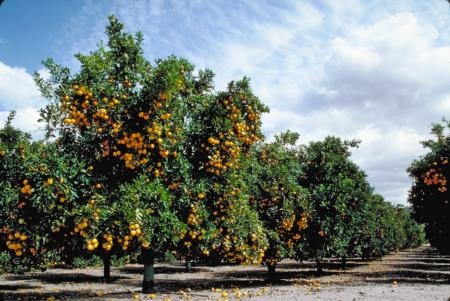
- Author: Chris M. Webb
Huanglongbing (HLB) the deadly disease carried by the Asian citrus psyllid has recently been detected in Los Angeles County.
UCCE Ventura County Farm Advisor Ben Faber, stresses that people are responsible for much of the movement of ACP. On their own, this insect roughly the size of a grain of rice, can travel about a mile over their lifetime.
The health of citrus trees, and the health of our local citrus industry, largely depends on the responsible handling and movement of plant materials and fruit. This is of particular importance when traveling out of the county, state or country.
Please see the message below from the CDFA (California Department of Food and Agriculture).
CITRUS DISEASE HUANGLONGBING DETECTED IN HACIENDA HEIGHTS AREA OF LOS ANGELES COUNTY
SACRAMENTO, March 30, 2012 – The California Department of Food and Agriculture (CDFA) and the United States Department of Agriculture (USDA) today confirmed the state’s first detection of the citrus disease known as huanglongbing (HLB), or citrus greening. The disease was detected in an Asian citrus psyllid sample and plant material taken from a lemon/pummelo tree in a residential neighborhood in the Hacienda Heights area of Los Angeles County.
HLB is a bacterial disease that attacks the vascular system of plants. It does not pose a threat to humans or animals. The Asian citrus psyllid can spread the bacteria as the pest feeds on citrus trees and other plants. Once a tree is infected, there is no cure; it typically declines and dies within a few years.
“Citrus is not just a part of California’s agricultural economy; it’s a cherished part of our landscape and our shared history,” said CDFA Secretary Karen Ross. “CDFA is moving swiftly to protect the state’s citrus growers as well as our residential trees and the many prized citrus plantings in our parks and other public lands. We have been planning and preparing for this scenario with our growers and our colleagues at the federal and local levels since before the Asian citrus psyllid was first detected here in 2008.”
Officials are making arrangements to remove and dispose of the infected tree and conduct treatment of citrus trees within 800 meters of the find site. By taking these steps, a critical reservoir of disease and its vectors will be removed, which is essential. More information about the program will be provided at an informational open house scheduled for Thursday, April 5, at the Industry Hills Expo Center, The Avalon Room, 16200 Temple Avenue, City of Industry, from 5:30 to 7:00 pm.
Treatment for HLB will be conducted with the oversight of the California Environmental Protection Agency (Cal-EPA) and will be conducted safely, with advance and follow-up notices provided to residents in the treatment area.
An intensive survey of local citrus trees and psyllids is underway to determine the source and extent of the HLB infestation. Planning has begun for a quarantine of the infested area to limit the spread of the disease by restricting the movement of citrus trees, citrus plant parts, green waste, and all citrus fruit except what is commercially cleaned and packed. As part of the quarantine, citrus and closely related plants at nurseries in the area will be placed on hold.
Residents of quarantine areas are urged not to remove or share citrus fruit, trees, clippings/grafts or related plant material. Citrus fruit may be harvested and consumed on-site.
CDFA, in partnership with the USDA, local agricultural commissioners and the citrus industry, continues to pursue a strategy of controlling the spread of Asian citrus psyllids while researchers work to find a cure for the disease.
HLB is known to be present in Mexico and in parts of the southern U.S. Florida first detected the pest in 1998 and the disease in 2005, and the two have now been detected in all 30 citrus-producing counties in that state. The University of Florida estimates the disease has tallied more than 6,600 lost jobs, $1.3 billion in lost revenue to growers and $3.6 billion in lost economic activity. The pest and the disease are also present in Texas, Louisiana, Georgia and South Carolina. The states of Arizona, Mississippi and Alabama have detected the pest but not the disease.
The Asian citrus psyllid was first detected in California in 2008, and quarantines are now in place in Ventura, San Diego, Imperial, Orange, Los Angeles, Santa Barbara, San Bernardino and Riverside counties. If Californians believe they have seen evidence of HLB in local citrus trees, they are asked to please call CDFA’s toll-free pest hotline at 1-800-491-1899. For more information on the Asian citrus psyllid and HLB visit: http://www.cdfa.ca.gov/phpps/acp/
